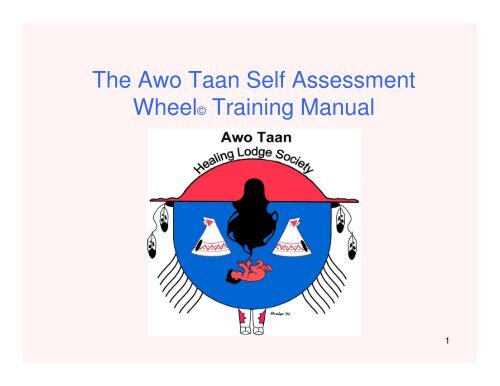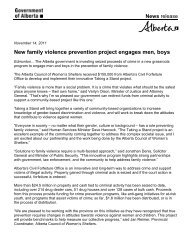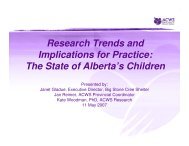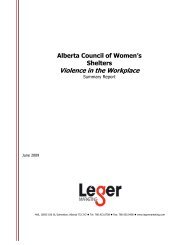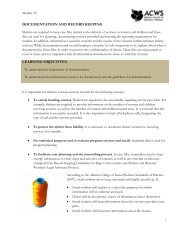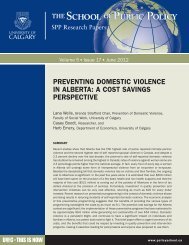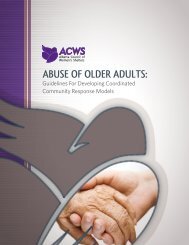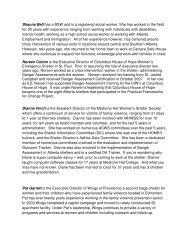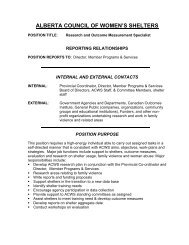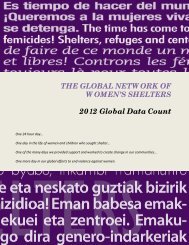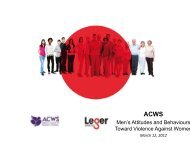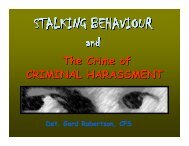The Awo Taan Self Assessment Wheel© Training Manual
The Awo Taan Self Assessment Wheel© Training Manual
The Awo Taan Self Assessment Wheel© Training Manual
You also want an ePaper? Increase the reach of your titles
YUMPU automatically turns print PDFs into web optimized ePapers that Google loves.
<strong>The</strong> <strong>Awo</strong> <strong>Taan</strong> <strong>Self</strong> <strong>Assessment</strong><br />
Wheel© <strong>Training</strong> <strong>Manual</strong><br />
1
Presenters:<br />
Josie Nepinak, Executive Director<br />
Carolyn Woodroffe, Residential<br />
Program Coordinator<br />
2
Introduction<br />
History of Development<br />
• <strong>Awo</strong> <strong>Taan</strong> Native Women’s Shelter – 1993<br />
• <strong>Awo</strong> <strong>Taan</strong> Initial <strong>Assessment</strong> Wheel –<br />
2003<br />
• Aboriginal Framework Model – 2005<br />
• <strong>Awo</strong> <strong>Taan</strong> Healing Lodge – 2007<br />
• <strong>Awo</strong> <strong>Taan</strong> <strong>Self</strong> <strong>Assessment</strong> Wheel<br />
<strong>Training</strong> <strong>Manual</strong> – 2007<br />
3
Elder Advisors<br />
• Annie Bare Shin Bone (Blackfoot)<br />
• Carolla Calf Robe (Blackfoot)<br />
• Beryl Kootenay (Stoney)<br />
• Andy Black Water (Blackfoot)<br />
• Patrick Deranger (Dene)<br />
• Florence Large (Cree)<br />
• Tom Crane Bear (Blackfoot)<br />
• Olive Manitopyes (Cree)<br />
4
Research<br />
<strong>The</strong> training model was grounded in<br />
research drawn from:<br />
• Medicine Wheel models across North<br />
America<br />
• Family Resilience Research<br />
• Strengths Perspective<br />
• Aboriginal Conceptualizations of Healing<br />
& Wellness<br />
5
Purpose/Value<br />
<strong>The</strong> <strong>Awo</strong> <strong>Taan</strong> <strong>Self</strong> <strong>Assessment</strong> Wheel©<br />
<strong>Training</strong> <strong>Manual</strong> was developed to benefit<br />
service providers dedicated to working<br />
with Aboriginal women in the promotion of<br />
violence-free lifestyles and wholistic<br />
wellness.<br />
6
<strong>Training</strong> <strong>Manual</strong><br />
Learning Objectives<br />
<strong>The</strong> teachings will enhance counselors<br />
capacity to:<br />
1 Identify and articulate the various<br />
components and meaning of the<br />
Medicine Wheel.<br />
2 Describe the differences between the<br />
physical, mental, emotional and spiritual<br />
aspects of wellness.<br />
7
3 Understand the value and benefits of<br />
the assessment wheel.<br />
4 Outline the assessment wheel process<br />
and the benefits from its continued use.<br />
5 Describe the steps in applying the <strong>Self</strong><br />
<strong>Assessment</strong> Wheel.<br />
8
6 Learn how to apply the <strong>Self</strong> <strong>Assessment</strong><br />
Wheel in developing goals and activities<br />
to improve well being and to guide case<br />
management best practices.<br />
7 Learn about the value of the traditional<br />
knowledge of Elders and the transfer of<br />
that knowledge as sacred.<br />
9
Extent of the issue<br />
• Among the most serious health problems<br />
affecting Aboriginal people in decades,<br />
since the Second world War are injuries<br />
sustained as a result of accidents &<br />
violence.<br />
10
<strong>Self</strong> <strong>Assessment</strong> Wheel <strong>Training</strong><br />
<strong>The</strong> <strong>Training</strong> <strong>Manual</strong> is presented in four parts<br />
with two assumptions:<br />
Assumption #1:<br />
In mainstream society, the majority of shelter<br />
professionals are non-Aboriginal and may<br />
benefit from an Aboriginal perspective.<br />
Assumption #2:<br />
<strong>The</strong>re is often a high turnover of shelter staff.<br />
<strong>The</strong> manual provides a foundation for learning.<br />
11
<strong>Training</strong> <strong>Manual</strong>: Part I<br />
• Provides an overview of family violence in<br />
general with a focus on Aboriginal family<br />
violence within an historical context of<br />
colonization.<br />
• This context further shapes how family<br />
violence is defined and manifested.<br />
12
<strong>Training</strong> <strong>Manual</strong>: Part II<br />
• Examines Aboriginal conceptualizations of<br />
healing and wellness.<br />
13
<strong>Training</strong> <strong>Manual</strong>: Part III<br />
• Provides detailed training on how to<br />
incorporate the wheel as a practice tool.<br />
• <strong>The</strong>re are three sub-sections which<br />
address unique populations:<br />
1. Healing Lodge Shelter residents<br />
2. Parent-Link Centre (resource centre)<br />
3. Outreach Program (community based)<br />
14
Wellness Counselor’s Checklist<br />
15
<strong>Awo</strong> <strong>Taan</strong> <strong>Self</strong> <strong>Assessment</strong> Wheel©<br />
16
Pre <strong>Assessment</strong> example<br />
18
Post <strong>Assessment</strong> example<br />
19
Sample population of Client Pre & Post<br />
<strong>Assessment</strong> Scores January - December 2010<br />
Sample Client<br />
Population<br />
Physical Mental Spiritual Emotional<br />
Person 1-pre 1 2 4 2<br />
Person 1-post 3 3 4 3<br />
Person 2-pre 2 2 1.5 1<br />
Person 2-post 3.5 3 2 3<br />
Person 3-pre 1 2 2 2<br />
Person 3-post 2 2 2 3<br />
Person 4-pre 2 2 1 2<br />
Person 4-post 3 3 4 3<br />
Person 5-pre 2 2 2 1.5<br />
Person 5-post 3 3.5 3.5 3<br />
Person 6-pre 2 3 1 1<br />
Person 6-post 3 3 2 2<br />
A few<br />
comments from<br />
ex-residents:<br />
“…very supportive and<br />
helpful”<br />
“” I liked the<br />
encouragement and<br />
positive attitudes”<br />
“Very insightful helpful<br />
and empathetic”<br />
“Helped me to find<br />
solutions for future<br />
living arrangements &<br />
explored feeling about<br />
personal situations”<br />
Person 7-pre 2 2 1 3<br />
Person 7-post 4 4 2 3<br />
Person 8-pre 2 2 3 1<br />
Person 8-post 2.5 3 3 2<br />
Person 9-pre 2 3 4 2<br />
Person 9-post 3 3 4 3<br />
20
Graph<br />
21
<strong>Training</strong> <strong>Manual</strong>: Part IV<br />
• Provides information on the application of<br />
the <strong>Self</strong> <strong>Assessment</strong> Wheel and the<br />
dimensions of Well-Being:<br />
Key Areas of Growth<br />
22
<strong>The</strong> <strong>Awo</strong> <strong>Taan</strong> <strong>Self</strong> <strong>Assessment</strong><br />
Wheel© <strong>Training</strong> <strong>Manual</strong> can be<br />
purchased through <strong>Awo</strong> <strong>Taan</strong> Healing<br />
Lodge Society.<br />
To purchase a copy, please contact<br />
Josie Nepinak at 405-531-1970 ext<br />
202<br />
23
Thank You.<br />
24


